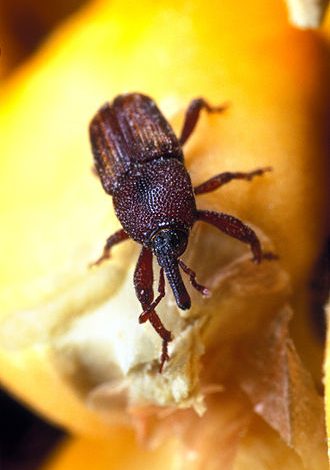Maize weevil

The maize weevil (Sitophilus zeamais), known in the United States as the greater rice weevil,[1][2] is a species of beetle in the family Curculionidae. It can be found in numerous tropical areas around the world, and in the United States, and is a major pest of maize.[3] This species attacks both standing crops and stored cereal products, including wheat, rice, sorghum,[4][5][6] oats, barley, rye, buckwheat,[6] peas, and cottonseed. The maize weevil also infests other types of stored, processed cereal products such as pasta, cassava,[5] and various coarse, milled grains. It has even been known to attack fruit while in storage, such as apples.[7]
A close relative of the rice weevil,[6] the maize weevil has a length of 2.3 mm to 4.9 mm. The type of food consumed by the larvae influences the size of the adult (3.9-4.9 mm on corn, 3.0-4.6 mm on wheat, 2.9-4.3 mm on rice, 2.7-3.2 on rough rice, and 2.3-3.9 mm on shelled rice).[8] This small, brown weevil has four reddish-brown spots on the wing covers (elytra). It has a long, thin snout, and geniculate (elbowed) antennae.[6] Sitophilus zeamais appears similar to the rice weevil (Sitophilus oryzae), but has more clearly marked spots on the wing covers, and is usually somewhat larger.[2] It is able to fly.[6]
The maize weevil and the rice weevil look very much alike but external features can be used to differentiate the vast majority of adults. However, the only reliable features to distinguish adults of both species are on the genitalia (see table below). Both species can hybridize. The genitalic structure of hybrids is unknown.[9][10][11][7]
S. zeamais occurs throughout warm, humid regions around the world, especially in locations where maize is grown,[2] including: Polynesia, Argentina, Brazil, Burma, Cambodia, Greece, Japan, Morocco, Spain, Syria, Turkey, United States, USSR, Sub Saharan Africa and Yugoslavia. It is also widely distributed throughout agricultural areas of northern Australia.[7] This species has also been recorded in Canada, in the provinces of Ontario and Quebec,[6] and has been intercepted at ports, but is not well established there. It has, however, been present for several years in Montreal, where grain from the U.S. is stored.[12]
The complete development time for the life cycle of this species averages 36 days.[7] The female chews through the surface of the grain, creating a hole. She then deposits a small oval white egg, and covers the hole as the ovipositor is removed, with a waxy secretion that creates a plug.[6] The plug quickly hardens, and leaves a small raised area on the seed surface. This provides the only visible evidence that the kernel is infested.[7] Only one egg is laid inside each grain. When the egg hatches into a white, legless grub, it will remain inside and begin feeding on the grain. The larvae will pupate while inside, then chew a circular exit hole,[1] and emerge as an adult beetle. A single female may lay 300 to 400 eggs during her lifetime. Adults can live for 5 to 8 months.[2] Breeding conditions require temperatures between 15 and 34 °C and[vague]40% relative humidity.
When the adults emerge, the females move to a high surface and release sex pheromones. Males are then attracted to this pheromone.[7]
